Lost in Translation Sixty Two
October 28, 2010
23:18 PM
Seen tonight in a restaurant in Languedoc- which kindly provided English translations of their offerings.
The Pizza on offer was entirely respectable in French ;
Fermiere : Nappage de creme et de tomate, emmincees de dinde, mais, poivrons et oignons
In English this read.
Farmers : Wife, topping of cream and toato, scilced thin by a turkey, mais let us add pepperonions
I should say that the Irish Countrywomans Association would have something to say about that.
I just plumped for the Romana.
5 comments
Dulce de Membrillo
October 27, 2010
04:57 AM
On Sunday evening Síle and I headed on our usual perambulation of the village, one of the joys of autumn and winter as in the summer it is just too hot.
Now in the course of the walk we go through a small cleft in the valley which has a late flowering quince tree and usually keeps a few quinces for us at this time.
We got five firm downy beauties.
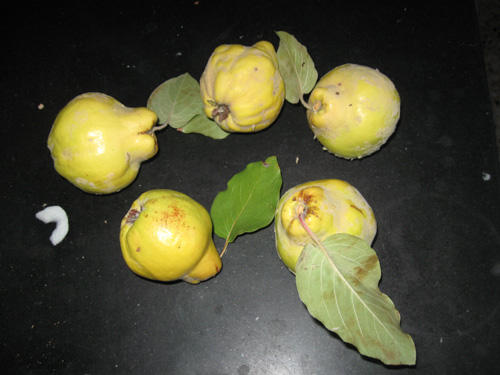
Now we have been lucky with our supply of quinces this year, lots growing in the hedgerows and our friends Barry and Mary have given us some from their garden in the village here, so for once I think I have enough Jelly to last out.
I thought it was a good time to try out a recipe I have been thinking of doing for a while.
Here is the Wikipedia entry:
Dulce de membrillo or Carne de membrillo in Spanish, marmelada in Portuguese, codonyat in Catalan, cotognata in Italian, is a sweet spread or a dessert (quince paste, quince jelly, quince candy or quince meat).
Traditionally and predominantly from Portugal, Italy (exported when the South of Italy was Catalan) and Spain, dulce de membrillo is a firm, sticky, sweet reddish hard paste made of the quince (Cydonia oblonga) fruit.[1] Dulce de membrillo is also eaten in some other countries of America, such as Argentina, Chile, Mexico and Uruguay.
Dulce de membrillo is made of quince fruit, sugar and water, cooked over a slow fire. It is sweet and mildly tart, and similar in consistency, flavor and use to guava cheese or guava paste.[2] It is sold in squares or blocks, then cut into thin slices and spread over toasted bread or sandwiches, plain or with cheese, often served for breakfast or as a snack, with manchego cheese or mató cheese. It is very often used to stuff pastries.
The usual classic recipe is to peel and core the fruit, cut it into cubes and cook it , in water, until soft.
Because they contain most of the pectin you also include with the cores and skins ( in a muslin bag for easy extraction. )
I, of course , think I know better, and being the proud possessor of a Mouli Legumes (available for a few Euro in any supermarket here and in cookshops in Ireland)I decided to do it the easy way.
If you dont have a Mouli (and you should !) you can use a strong sieve and push it through.
Now before any Irish readers think I am just dangling unavailable carrots about with talk of quinces I offer three alternatives, freely available in Ireland or England, with which you could make Membrillo Paste.
The fruit of the Japonica makes an excellent quince substitute, I have used it several times, I am also convinced that crab apples treated the same way would produce a most interesting paste and, if all fruit fails, welcome the humble apple- I padded out my quinces with some Granny Smiths here and they did it no harm.
Here is how I made it.
First give the quinces a rub under the tap to remove any grey fluff.
Now cut into small cubes, skin core and all.
Cover with water and simmer slowly for about 30 minutes until very soft.
(They can take longer if a little unripe)
Now put the fruit and juice through the mouli (or push through a sieve)
Using a fine blade will trap all the skins and the pips.
Measure the amount pushed through and add three quarters of its weight in castor sugar, ie 750g of sugar, for 1 litre of pulp extracted.
If I was using apples I would add the juice of a lemon at this stage.
(In fact, no matter what fruit you use, the juice of a lemon at this stage is no harm, it is untraditional but adds a little acidity)
Now put the sugar and pulp in a saucepan, bring to the boil slowly until the sugar is dissolved and then continue to simmer slowly , stirring all the time, for another thirty minutes.
The mixture can stick very easily so you want to be extremely vigilant with the stirring, particularly in the edges of the pot.
Be careful also with the little volcanic eruptions which happen from time to time.
The erupting paste can burn like lava.
You will know it is ready when the paste leaves a definite trail when you draw your wooden spoon through.
Now line a deep swiss roll tin with nonstick paper and pour in the paste and then leave it set.
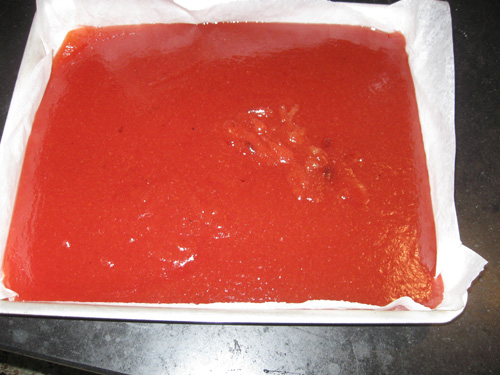
Once set like a firm jelly cut it into squares and wrap each in non stick paper.
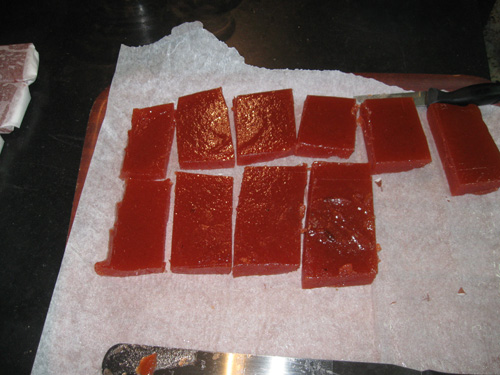
Kept in a fridge they say it should last for several months.
It is absolutely delicious served in thin slices with goats cheese or even with blue cheese.
I am going to be investigating other uses as well.
Recurring Nightmare
October 26, 2010
07:56 AM
As a very unindustrious student all my scholastic life (and I ended up being in education of some sort between 1955 and 1972 ) I tended to approach exams with a sort of unfounded confidence that I could attempt them without really bothering to study or revise and I would somehow sail through.
In a way this almost worked, even though it took me several attempts I did end up with a (pass) BA degree at the end of my academic career.
The nasty thing is that this confidence has come back to haunt me in the form of a recurring nightmare.
It is, I gather, a not uncommon nightmare, even among those swots who actually revised for exams.
The nightmare scenario is that you are just about to sit an exam, usually about something of which you have heard but know absolutely nothing , and you go into a blue funk wishing that you had done some study.
Usually I wake up in a panic and sweat at that point.
Last night while asleep, for the first time ever I went and sat the nightmare exam.
The strange thing was that it wasn’t at all bad, I kept being pleasantly surprised that I could answer the questions with just a little common sense.
I awoke refreshed and confident and came downstairs and wrote this blog.
Have I now exorcised the nightmare of the unstudied for exam ?
Or am I now going to be taken over by Studynightmare Number Two :
The Results.
2 comments
Bonanza
October 26, 2010
07:36 AM
I came back from my holiday in Sanlucar with two problems of etymology.
The first referred to the title of this piece; Bonanza.
This is the name of the little fishing port which is just up the coast from the town of Sanlucar, it is so close (we walked up the beach to it in a half hour) that it qualifies as being part of the town and is in fact officially known as Bonanza de Sancucar de Barrameda.
Now we all know that a bonanza is a stroke of luck, or a sudden happy event.
The OED led me back through the Latin Bonus, good, to it meaning good weather.
But no-one one seemed to know how the port got named.
I found the answer in my reliable Encyclopaedia Britannica, 11th edition, all 32 large volumes of which I have managed to carry with me throughout my married life. (Even though they now rest in ignominy on the floor of the attic in France they are soon to be well housed.)
The Spanish government as they began to realise that the conquest of the Americas was a Good Thing (gold and silver being certainly Good Things) founded, as all colonial governments do, a company to take care of the business which they called The South American Company.
This was based in Seville, just up the river from Sanlucar.
To propitiate the Gods or in this case Nuestra Senora, they took out an insurance policy with them and built a church at the port of Sanlucar which they called La Virgin de Bonanza- Our Lady of Good Weather.
The port then was named after the church.
That problem of origin solved leads me neatly to my second, as yet unsolved, etymological mystery.
This is the reason why our local church was known as the church De Nuestra Senora de la O- or the church of Our Lady of the O.
The best (of a bad lot) explanation I can find so far is that at the moment of birth Nuestra Senora said O, and this then became symbolic of the Virgin Birth,
much celebrated in Spain, as is the Immaculate Conception.
My researches continue.
2 comments
The Procession of Sant Lucas
October 25, 2010
16:22 PM
On the third day of our holiday we headed into Jerez, the original home or Sherry- of which more later.
We arrived home in Sanlucar at about 8 only to find there was a lot of excitement just out side the church of Our Lady of O, which was next to our flat.
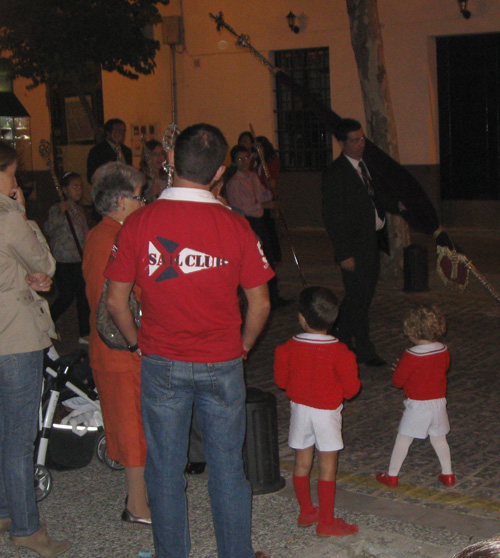
People were lined up on the streets (NB the immaculate outfits of these brothers in red and white,they were dressed like little royal princes in outfits matching their father’s and they also wore medallions on leather thongs around their necks)
We were obviously going to have a religious procession of some importance.
It turned out to be the feast of St Lucas whose statue stood in the church of Our Lady of O.
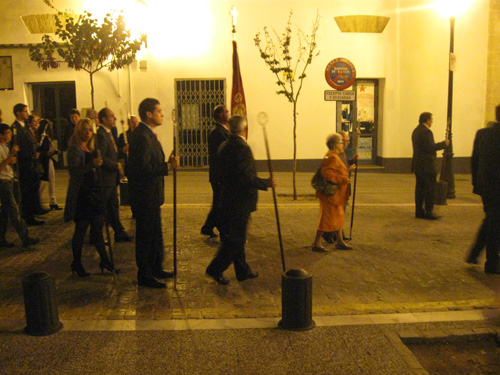
From the distance we could hear the sounds of a large brass band playing a repeating fanfare accompanied by a strong beating of drums.
The sound had an entirely primitive resonance and both of us could feel a real sense of excitement in the air.
The first to arrive were the lay representatives of the parishes in the town, they carried sceptres and all walked extremely slowly, pausing frequently.
Whatever was following was making very slow progress.
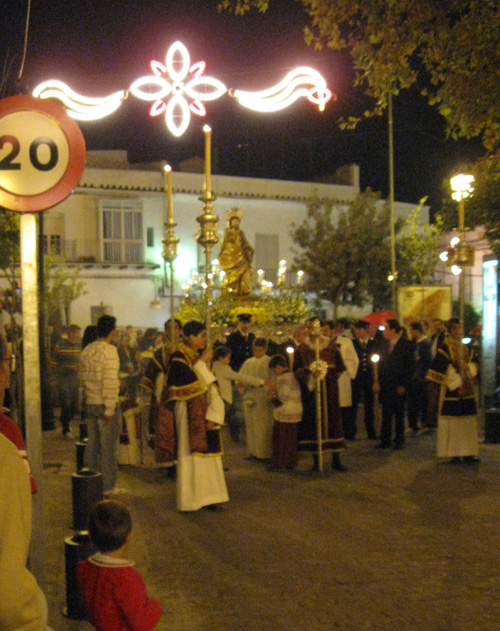
Then at last around the corner arrived the Saint himself, on a sort of heavily decorated palanquin, loaded with lillies and accompanied by beautifully dressed candle bearers, and clerics and seeming to float forward on wheels.
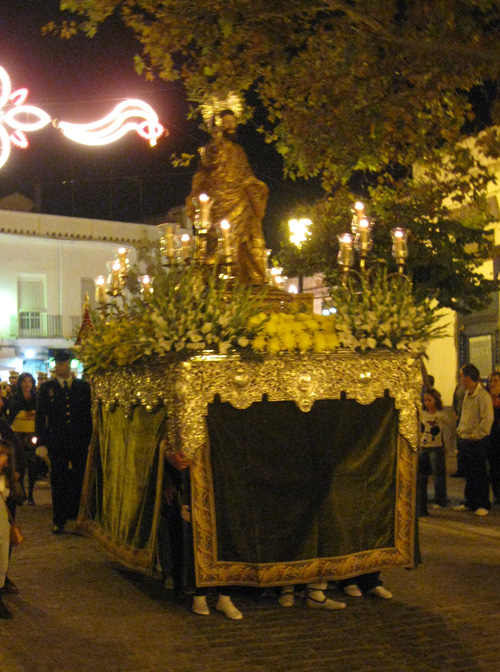
It was, it turned out being carried by 18 men all hidden under a curtain, only their white clad feet visible as the inched forward with a well rehearsed heel to toe movement
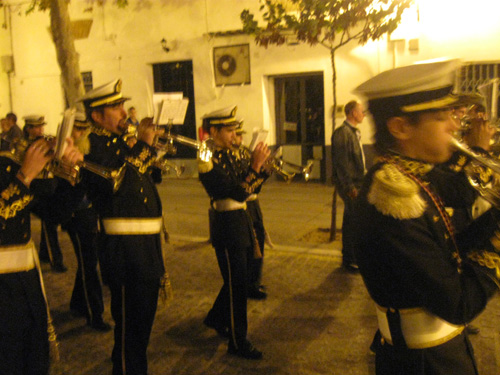
Following them and playing an eerie fanfare were a band of about 20 trumpeters.
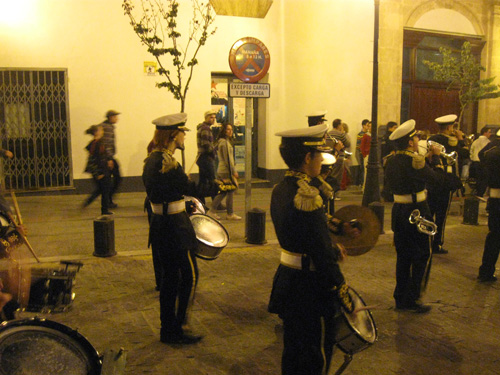
And after them were about 20 drummers drumming, the effect was enough to make the hairs rise up on your neck.
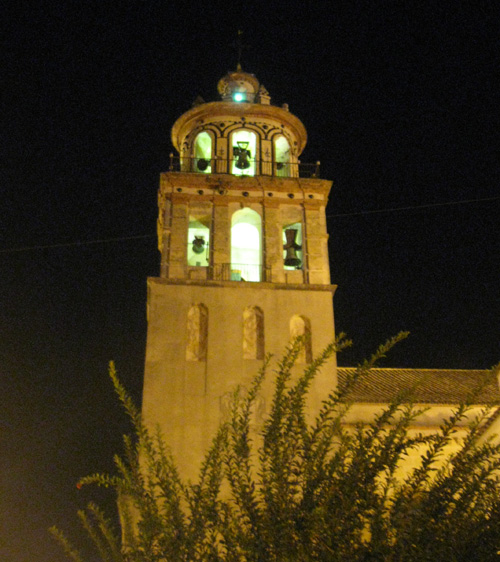
Then to add further to the atmosphere the bells of Our Lady of O started to clang and ring loudly through the night.
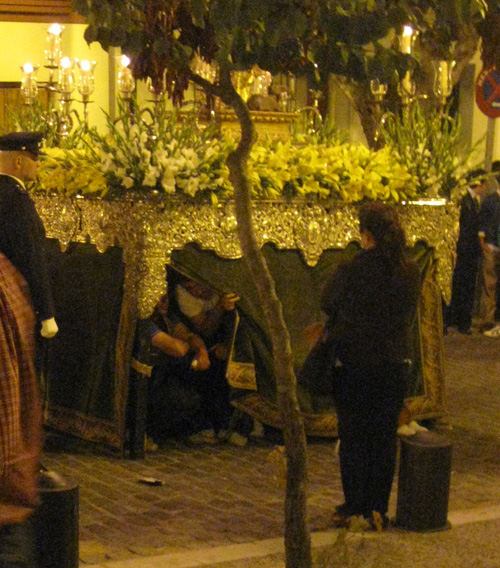
Then the procession had another of its stops, giving the exhausted bearers time for a quick hunker down and a request for hankies to mop their streaming faces.
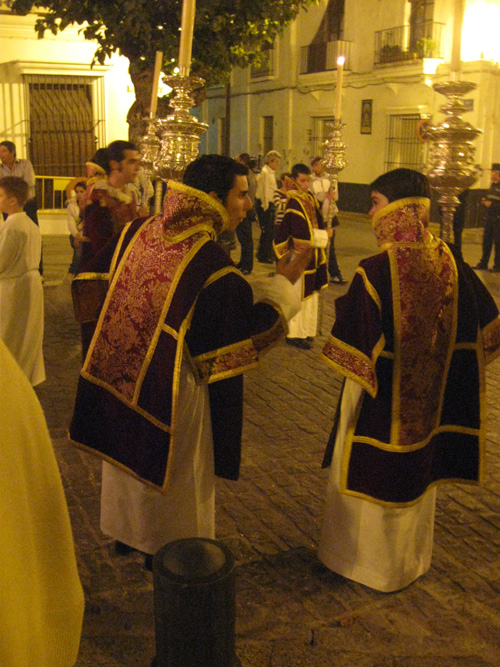
Unfortunately this gave some of the acolytes time for a row.
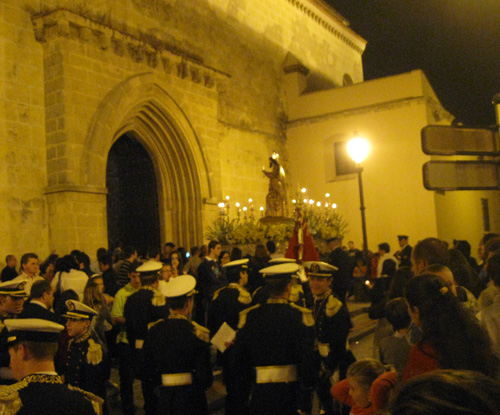
But then the procession started up again and mounted the steps into the church.
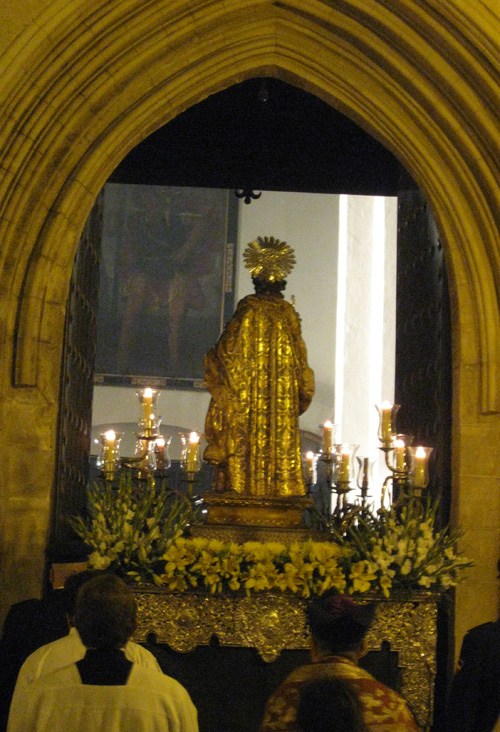
And Sant Lucas was brought back home safely.
First Pictures from Sanlucar
October 25, 2010
11:13 AM
Here are some pictures taken of our apartment in Sanlucar.
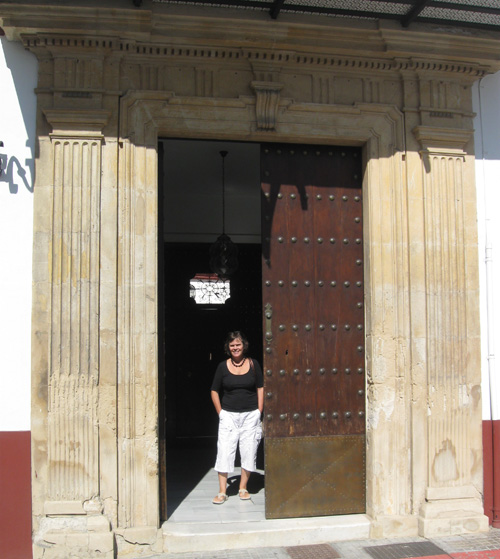
This was our front door, on a tiny narrow street which gave no idea what was behind it.
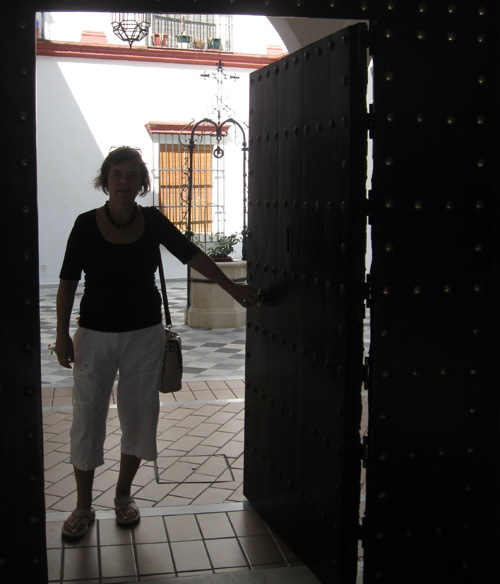
Opening the door led on to a marvellous cool marble tiled courtyard, complete with its original well in the centre.
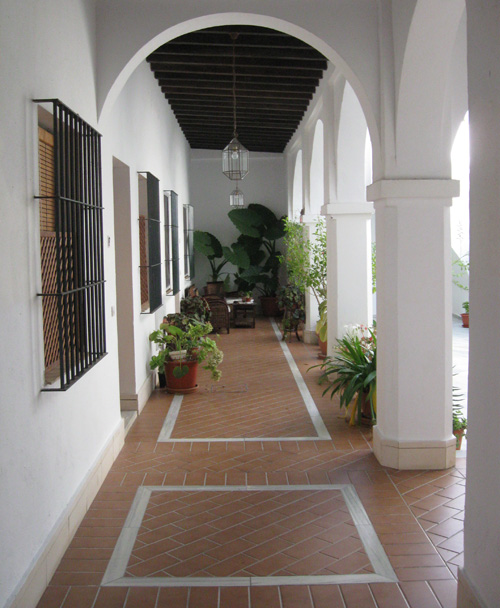
And from there we went through another series of courtyards and arcades.
(there must have been an acre, and about 100 apartments behind that door)
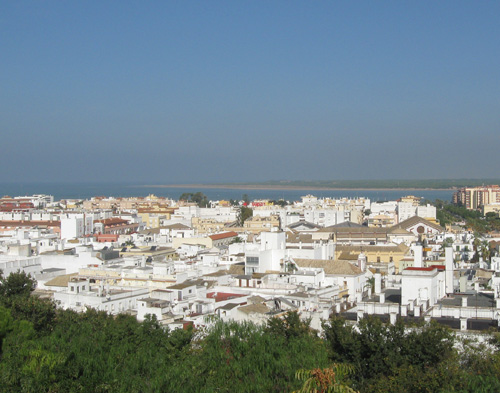
And then finally we arrives at our apartment which was like a balcony above the town of Sanlucar, you could see the whole town with its many many churches, across the mouth of the Guadalquivir and across the river to the Doñana National Park.
Bonanza Beach
October 23, 2010
17:20 PM
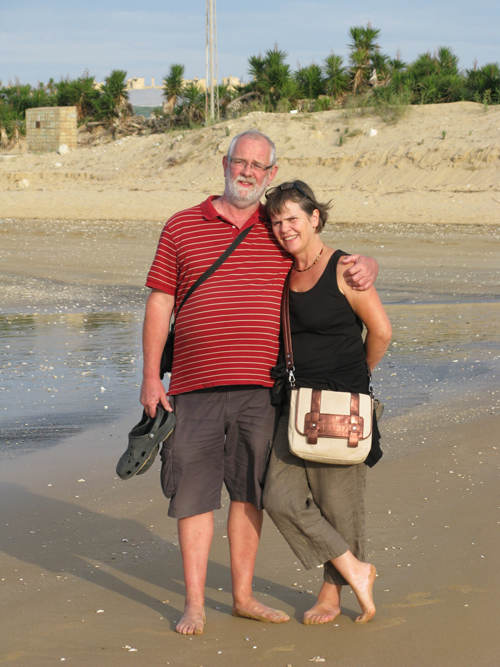
Síle and I on the way to Bonanza from Sanlucar, picture by Michael.
1 comment.
Sanlucar Diary, Part One
October 19, 2010
15:46 PM
There follows an unedited account of our first few days holiday.
There will be more and loads of pictures soon.
We got into Sanlucar de Barrameda yesterday afternoon having made only one mistake on the route from Manilva.
We had been only two hours on the road but had totally moved both Geographically and culturally. Once we had passed the Rock of Gibraltar we had moved out from the modern area of British colonisation and back into Spanish Spain, we had also moved from the Mediterranean into the Atlantic.
We had passed through all the hideous built up seaside towns of the Med and into the Cotton Fields (they were harvesting the cotton with huge harvesters) and vineyards of that area between Cadiz, Jerez and Sanlucar which some call the Sherry Triangle.
Sanlucar –which looks like a town on the atlas- is in fact a city of Waterford proportions.
There the comparison ends.
In the packed and narrow labyrinth of back streets in the Barrio Altro, the old town where we had rented an apartment, all the houses were whitewashed with ornate wrought iron window coverings and streets so narrow that passage, let alone parking, were extremely difficult. We didn’t find out house (even though it was number 1, it was next to number 12, it turned out) but arranged to meet our landlady, Cruz, outside the church of Notre Senñora de la O.
She said she would be about ten minutes, she could have been an hour because as we waited outside the church wedding party began to arrive.
The Style was fantastic.
All the men were in glistening Mohair suits (remember them) some in a yellowish beige which made them look as though dressed in cloth of gold.
The ladies, all very glamorous, were in the shortest of mini-skirts with amazing rouched and ruffled dresses but it was the matching shoes which were a wonder.
Always the same colour as the dress ( or at least the handbag) they were as high as heels could be and frequently had complicated ribbon systems which fastened in bows or even little bunches of flowers about the ankles. In the really stylish couples the mans tie was the same colour as the ladies dress.
They were a triumph.
A lot of guitarists, carrying their instruments also arrived so there was obviously going to be a Flamenco element to the service.
I had scooted for a quick look at the church before their arrival and it is a prime example of the Spanish Baroque, the entire altar wall is gilded with cherubs angles and saints.
Cruz- pronounced Cruth, soon arrived and brought us to the few houses away which was to be our home for the week.
The doorway was impressive but nothing like as impressive as what was inside.
We were led through a large Moorish courtyard, tiled in black and white and with an ornate well in the middle, then through another and another until we came to climb the stairs to our apartment.
We were right up on the top of the building with a huge terrace right over the town of Sanlucar with a view to the mouth of the Guadalquiver from where Columbus set out to find America.
A true balcony over Europe.
I had picked Sanlucar with a pin on the map as I looked for the first town on the Atlantic west of Gibraltar which looked big enough to have sufficient restaurants where we could eat out every night without repeating ourselves.
We have spent the last six months, indeed the last four years if you count preparation time, getting our Chambre d’Hote in the Languedoc in the south of France up and running.
The running meant that since June last I had been cooking nearly every night for anything from four to twelve hungry people from the kitchen of Thezan les Beziers.
This was to be our first holiday proper since that time we had found Le Presbytere now over four years ago.
I had picked Spain for the possibility of a bit of heat left in the wintering sun and because my old pal and best man, Michael lived in Manilva and would give us a base to explore the region.
Michael true to his word, went and explored Sanlucar for us, gave it a double thumbs up, sent me the second half of Neal Stephenson’s swash buckling best seller “The Confusion” (set partially in Sanlucar, partially in Co Clare) and even tried out some of the restaurants declaring that the fish restaurant strip at the beach at the Baja de Guia was the place to go.
Obediently we set off there last night.
Of course we got hopelessly lost in the back streets, but, as it was the time of the Passeo, when all the family stroll the streets in their best clothes, we had plenty to look at.
At the Baja de Guia you pick the fish we want to eat, the shell fish looked magnificent, and then you pick how it is cooked, fried grilled, or sealed in salt.
The Dublin Bay Prawns were a frightening €110 a kilo, lobster something less so we plumped for some Dorados, Sea Bream, a mere snip at €45 the kilo.
We blanched just a little when the waiter told us that we would need a kilo for the two of us, but, emboldened by our first copita of Manzanilla we went for it and furthermore , lost the run of our selves by ordering a plate of Clams A l’Andaluse between the pair of us for a starter.
The clams were delicious, the sauce hot with garlic and just a touch of chilli used up just about all of our bread as we fought to mop up the remaining smears on the plate.
Then the waiters came out with two large Dorados, still entombed in salt for our approval before serving us.
These were taken away and brought back stripped of salt, skin and bones, huge platefuls of moist Sea Bream with some sharp Olive oil on the side and a salad of meticulously charred and skinned red and green peppers.
I don’t think I have ever eaten better fish.
The salt had preserved all the essences of the freshest of fish (we could just make out the fishing boats moored about 20 metres away) the olive oil and the peppers made the simplest and best accompaniment and again I had to ask for more bread to make sure I lost none of the juices.
We graduated from a glass of Manzanilla each to sharing a bottle of the same with our main courses. This was an excellent decision.
The slightly salty tang of the wine was just made for salt baked bream.
We neither wanted nor looked for anything else and waddled home content.
The wedding was still being celebrated in the Bodega of Barbadillo , the largest producer of Manzanilla in the town, just next door to us, and it may well have gone on for many hours after I fell asleep.
Just on the other side of our apartment is the palace of Medina Sidonia, the last home of the Red Duchess who divided her time between tormenting Franco from exile and then consolidating the archives of her family, at one time believed the richest in Europe, and still extremely wealthy.
The palace is open to visitors only on Sunday morning and our luck was in as there was a Swedish group booked in that Sunday and their tour was to be in English. and they let us join in.
The palace is amazing, full of Spanish art and antiques, some paintings by Goya, several tapestries designed by Rembrandt.
After the tour we went to a nearby Galician bar (bear in mind we are still within 100 metres of our apartment) where we ate an enormous salad of Tuna and Tomato (we left half of it behind) with bread and further copitas of Manzanilla for the princely sum of €13 for the two of us.
So far my ambition of eating all meals out is working; lunch in El Gallego was followed by a walk on the beach and a trip to the nearby beach town of Chipiona where we indulged in icecreams in a beach café.
That evening we decided we were only fit for a light supper and so sat at a bar in the Plaza San Roque and had plates of Boccorones Fritos (deep fried anchovies) and chips with further copitas of Manzanilla for me and red wine for Sile.
This time the bill was €16, or €8 a head.
On the way back up the hill from the restaurant we reckoned that to have bought the food and drink in the market and cooked it at home would have cost us more.
3 comments
Comhrá insan Bialann
October 14, 2010
13:43 PM
We are now blissfully visitor free and so, to celebrate we went down to Olivier and Cathy who run an excellent Pizzaria (Le Petit Pagnol) in the village, for lunch.
While we were there a man arrived in, map in hand, looking for a footpath which should be marked around the village.
After a couple of sentences in French we quickly realised he was not a native speaker , but , when we spoke in English it seemed he wasn’t completely happy in that language also.
He was the one who said to us “You are Irish aren’t you?” and then asked us what part.
He didn’t know Waterford, “I really only know the Gaeltacht areas” he said.
On an impulse I said “An tuigeann tú Gaeilge ?” and he then answered in fluent Irish.
He was, it turned out, a teacher of Scots Gaelic , and also spoke Irish fluently.
There followed a long conversation in Irish.
There we were in France, in the Languedoc, in an Italian Restaurant, speaking Irish avidly with a Scotsman.
C’est Bizarre.
2 comments
Shells
October 13, 2010
12:45 PM
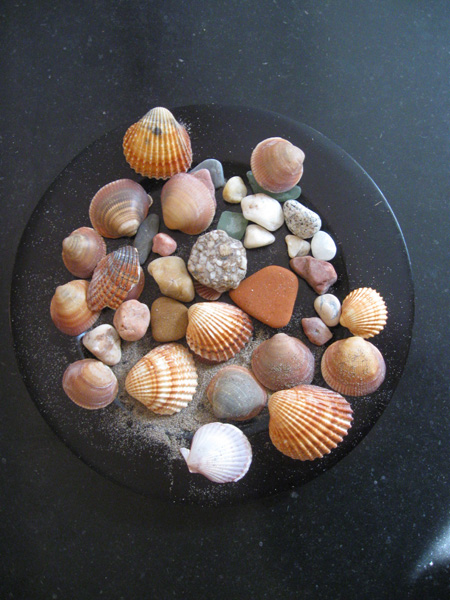
I find it impossible to walk a beach without doing a little light beachcombing.
Yesterdays walk in Vendres was no exception.
Interesting that the shells, stones, and rubbish on the beach, plentiful after the storms of the last week, reflect the colours ; terracotta, pink, lilac and grey, of the Languedoc.
|
